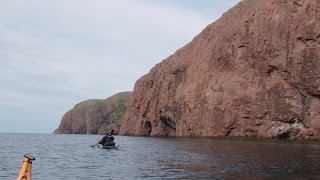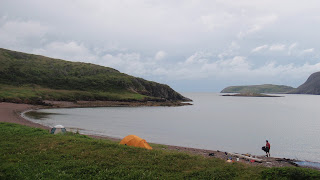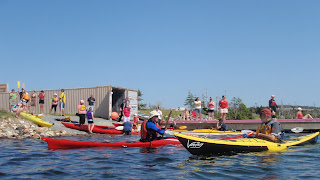 Loaded up and ready to go
Loaded up and ready to go
Stan proposed an overnight kayak camping trip earlier in the week. Some discussion and we settled on a paddle from Harbour Mille in Fortune Bay to the resettled community of Stone's Cove. Stan just wanted to paddle somewhere new, I thought visiting some of Newfoundland's historic abandoned communities would be a great added feature.
Scott Walden had visited the Province of Newfoundland some years ago with the intention of photographing the remains of some of Newfoundland's resettled communities. The result of that visit was a book entitled "Places Lost". These were isolated settlements that the Government of the day thought should be moved and the inhabitants consolidated in larger communities for access to modern conveninces.
We got into Harbour Mille Friday afternoon hoping to cross so that we'd have more paddling time on Saturday. It didn't happen as it was blowing with many whitecaps visible. We toured Harbour Mille and after some (too long for words) scouting, we found a nice spot off the road to put up our tents and catch some Zs for an early morning rise.
We got out of our sleeping bags around 4:30 am, made breakfast and headed to the harbour to put-in.
 Stan making progress in choppy waters
Stan making progress in choppy waters
We had to make a 5 km crossing of the northern part of Fortune Bay to get on the far shore that would take us to our destination of Stone's Cove.
It was better but still choppy. Not a problem for our fully loaded Nordkapps. I couldn't believe the handling of the boat with a bit of weight in it.
 Stan paddles along some massive red cliffs
Stan paddles along some massive red cliffs
This stretch of shore is exposed to south and south-western winds but today after we crossed the northern reaches of Fortune Bay the wind dropped and the water went calm. We were very fortunate and relieved to find that the wind had dropped so we could take our time to enjoy the scenery on offer today.
 Lunch beach at Friar Head
Lunch beach at Friar Head
We got the boats ashore an cooked lunch. Stan and I both made lunch and then halved it to give each other a different taste, so we had a smorgasbord!
Done lunch and cleaning up afterwards, Stan wanted to hike up to the hill overlooking the beach to see what was visable over the surrounding country. There wasn't much to see but turning back we has this great view looking back the bay and the great beach where we landed.
 Here lies Sabine Hatch
Here lies Sabine Hatch
Our first destination after lunch was Anderson's Cove. Stan spoke to a colleague at work who informed him a bit about Anderson's Cove so we wanted to visit there. We turned north into Long Harbour and Stan noticed the solitary grave overlooking Lobster Cove just inside the entrance to the "fjord" called Long Harbour. I had to get out to have a look and Stan patiently waited.
The name on the headstone was Sabine Hatch and she passed away in 1890 at the age of 36 years. Death at an early age was common for people living in the isolated bays of Newfoundland which locally are called "outports".
 Crant's Cove
Crant's Cove
We left Long Harbour and paddled to Crant's Cove around Long Harbour Point. Crant's Cove is one of the resettled communities features in Scott Walden's book "Places Lost". We came into the cove, with me thinking it was Stone's Cove. I recognized the graveyard with the massive hill behind it and thought it must be Crant's Cove, a community started by the Crants and Stones. The Stones subsequently moved over a cove to the left and settled Stone's Cove which went on to overshadow Crant's Cove in terms of size. Odd I thought as there were many more gravestones at Crant's Cove than at Stone's Cove.
I landed to get check out the graveyard and noted the family names of Dominix, Thornhill, Scott, Bond and notably Pope. That was interesting as we spoke to a fisherman earlier in the day who said his Grandmother was from Crant's Cove and her name was Pope.
Not only is Crant's Cove a place lost but so are the names of most of these families in the immediate area.
 Stone's Cove
Stone's Cove
Next stop after Crant's Cove was Stone's Cove which is also featured in "Places Lost". Stone's Cove is another one of Newfoundland's resettled communities. There was a substantial church and numerous houses but more on that later. It might have been abandoned but sometime later a few came back and built cabins to use when fishing in the area, repleat with satellite dishes!
 Home sweet home
Home sweet home
When we left Stone's Cove the wind picked up as did the seas. We had some challenging seas but I was impressed again how well the fully loaded Nordkapp handled in the quartering seas. Where to spend the night? I left it up to Stan and he led us back to Lobster Cove just inside the entrance to Long Harbour. Stan chose well as inside here it was calm.
We unloaded the boats, put up the tents and cooked supper. Cooked supper if you can call boiling water to dump into dehydrated food cooking! We chose for simple on this trip.
 Spellbound
Spellbound
After we made supper and washed the dishes (!!!) Stan and I picked up some firewood on the beach and had a fire. Something about a fire, ever changing, ever consuming, that is spellbinding. This was our entertainment for the night. It looked a bit like two guys looking at the idiot box but unlike TV, there was time to yak it up in between gathering wood to keep the "home fire burning".
At about 9:30 it started to rain and blow so we retreated to the comfort of out tents and sleeping bags. I wondered what tomorrow would bring for our trip home. We didn't have the luxury of a weather day.
Safe and out of the weather as the rain pounded the tent, I reflected on a fantastic day paddling with good friend and paddle mate Stan. 30 kms paddled wasn't a bad effort.






















































